|
|
|
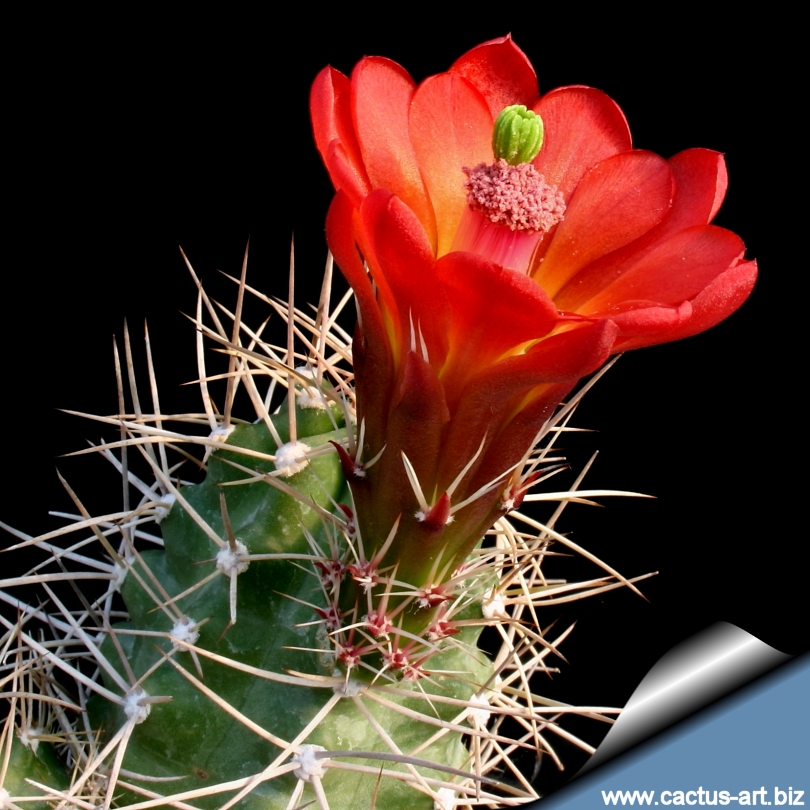
Echinocereus triglochidiatus
It is a beautiful plant with long-lasting, waxy, scarlet flowers,
which make it a favorite among gardeners.
|
|
Description:
In general it is a mounding cactus, forming bulbous piles of from a few
to hundreds of spherical to cylindrical stems. Plants may vary from
densely spiny (usually) to no spines at all. E. triglochidiatus
is the most
wide-spread of the Echiniocereus species and
is also the most
variable in appearance. I n fact, the several varieties are so different-looking that the only uniting factor is the bright red bloom and rounded
petals.
Stems: Usually erect , spherical or cylindrical, 3-70 cm tall,
5-13 cm in diameter;
Ribs: 5-8 or 8-12, crests slightly undulate (some populations
contain plants with strongly interrupted ribs);
Areoles: 10-40 mm apart, and somewhat woolly.
Spines (0-)3-11 per areole, with central spines being difficult
to distinguish from the radial spines. Straight to curved or contorted,
appressed (radial spines) or spreading to projecting outward (some
radials, and central spines when present), white to yellow, gray, or
sometimes nearly black, but those turn whitish-grey after their first
season.
Radial spines: (0-)1-10 per areole, (0-)15-90 mm long;
Spines are at first yellow, pink or black.
Central spines: 0-1(-4) per areole, angular, (0-)50-120 mm long.
Flowers: Diurnal, funnel-shaped, 5-10 × 3-7 cm; flower tube
20-35 mm; flower tube hairs 1-2 mm; inner tepals bright orange-red to
dark red, proximally paler (bases sometimes yellow or white), 25-40 ×
10-15 mm, tips thick and rigid; anthers usually pink to purple. There is
a thick nectar chamber and many thready pink stamens at the center of
the corolla. The flowers are pollinated by hummingbirds.
Fruits: Juicy, with deciduous spines, and edible, green to
yellow-green or pink (rarely red), (15-)20-35 mm, pulp white, fruiting
2-2.5 months after flowering...
Blooming season: Apr-June, the flowers remain open for 2 or 3
days.
Blooming generally begins 5 to 10 years
after sowing, as the plant matures.
|
|
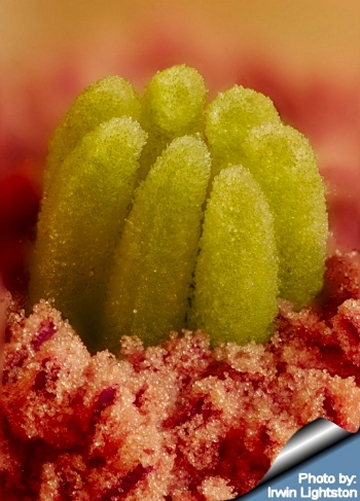
Photo
and ©
copyright by
Irwin Lightstone
(http://www.radiantimagesphotography.net
)
Stigma detail taken in my yard before sunset with a
Canon mpe 65mm at f4.5 at about 3.25x - lifesize, multiple images
composited with Helicon software. Artefacts, such as some minor fringing,
were removed with Photoshop. The green stigma was about the size of a
small grain of rice. |
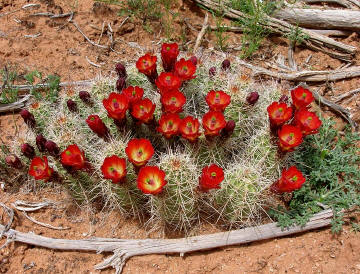
( Photo
and ©
copyright by:
Wilfried Stolz - Austria )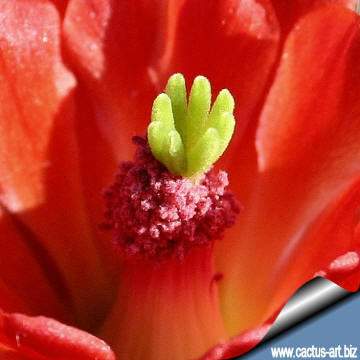 |
|
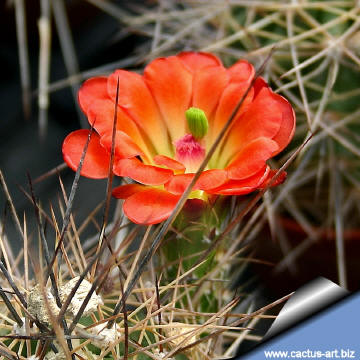 |
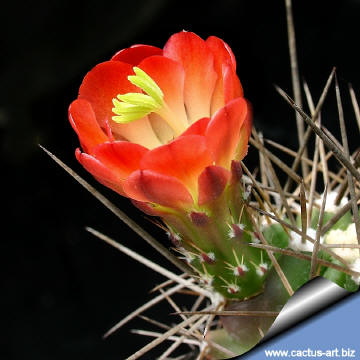 |
|
Photo of conspecific taxa, varieties,
forms an cultivars of Echinocereus triglochidiatus.

 |
|
Advertising
|
|
|
|
|
Family:
Cactaceae (Cactus
Family)
Scientific name:
Echinocereus triglochidiatus
Engelmann
in F. A. Wislizenus, Mem. Tour N. Mexico. 93. 1848.
Origin:
E. triglochidiatus is the most widespread
species (Nevada,
Utah, and Colorado south to southern California,
Arizona, New Mexico, Texas, and Mexico)
Habitat: It is a resident of many varied
habitats in the upper edge of
the Mojave Desert,
from low desert to rocky slopes, scrub, coniferous forests, igneous and
calcareous rock outcrops and cliffs.
It is most abundant in shady areas.
These plants can grow in colder climates because the stems clump so
closely together. This reduces surface area through which it can lose
heat.
It can grow in elevations from 150 to 3500 m.
Conservation status: Listed in
CITES appendix 2.
Synonyms:
- Cereus triglochidiatus
Engelmann 1848
- Cereus gonacanthus
- Echinocereus triglochidiatus
var. gonacanthus (Engelmann & J. M. Bigelow) Boissevain
- Echinocereus
paucispinus var. triglochidiatus Schumann 1896
- Echinocereus triglochidiatus var.
paucispinus
- Echinocereus triglochidiatus var.
mojavensis (Engelmann & J. M. Bigelow) L. D. Benson
- Echinocereus triglochidiatus var.
inermis (Schumann) Arp
Common Name: Claret-Cup
Hedgehog , Kingcup cactus, mound cactus, King's Crown Cactus, Spineless
Hedgehog,
Strawberry Cactus.,
Mound Cactus, Crimson Hedgehog, Claretcup Hedgehog, Curve-Spined Claret
Cup,, Mojave Hedgehog, Mojave Kingcup Cactus, Mojave Mound Cactus, Mound
Hedgehog-Cactus.
Etymology:
The genus name
Echinocereus
comes
from the Greek word "εχινος (Echinos)" meaning"
Sea-urchin
or
Hedgehog"
The species name "triglochidiatus" is formed by the prefix
“tri” meanening “three (3)” plus the Latin
word “glochidium” a “barbed hair of a plant
or a spine”
referring to the spines
found on areoles along the ribs, but not all
the plants bear clusters of three spines,
and usually more than three spines are found
in each cluster.
|
|
|
|
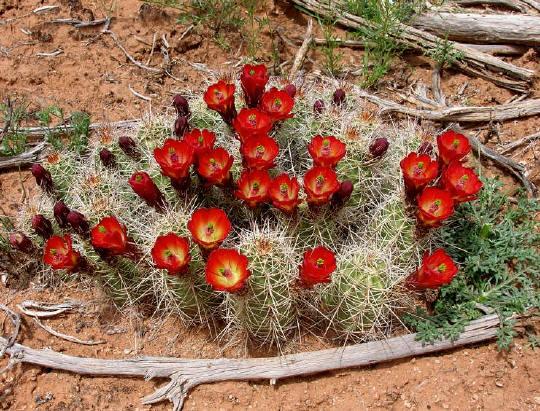
( Photo
and ©
copyright by:
Wilfried Stolz - Austria )
The glorious flower colour of the hedgehog cactus rivals that
of the desert sunset.
The flowers are a beautiful deep
red, with many petals that form the shape of a cup. They bloom from
April through June, and are the first to bloom in the desert.
There are a number of varieties of
this highly variable cactus species, but not all are universally
recognized. Some authorities recognize the following varieties:
E. triglochidiatus var. triglochidiatus Plants with the fewest
and largest spines, that occupy the eastern portion of the species’
distribution. The central or radial spines are sharply angular in cross
section, and 1-2 mm thick.
E. triglochidiatus var. arizonicus (Rose) L. Benson Arizona hedgehog
cactus (endangered): oak woodland
E. triglochidiatus var. gonacanthus a name carelessly applied to miscellaneous
plants throughout the range of var. triglochidiatus.
E. triglochidiatus var. gurneyi L. Benson : Chihuahuan desert, desert
grassland
E. triglochidiatus var. inermis Rowley spineless hedgehog cactus
E. triglochidiatus var. melanacanthus (Engelm.) L. Benson :Rocky
Mountain montane forest, pinyon-juniper woodland
E. triglochidiatus var. mojavensis (Engelm. & Bigel.) L. Benson :
Mojave desert, chaparral. This taxon includes curly-spined plants (mainly
in California) and straight-spined plants (including most populations in
Arizona, Utah, and western Colorado).
E. triglochidiatus var. neomexicanus (Standl.) Standl. ex W. T. Marshall
: oak, pinyon-juniper woodland
E. triglochidiatus var. paucispinus (Engelm.) Engelm. ex W. T. Marshall
The variety E. triglochidiatus var. toroweapensis
Fischer has been proposed.
A spineless form (var.
inermis) has been
applied at various taxonomic ranks to individual plants with spines
absent or nearly so in the eastern portion of var. mojavensis,
mainly found in the mountains and mesas of western Colorado and eastern
Utah. On these plants, areoles may have very few spines and some stems
can be almost completely spineless, but the same plant will have spined
stems and many spines per areole in another area.
Echinocereus triglochidiatus
is the earliest name for a large group of diploid and polyploid taxa
treated as conspecific by L. D. Benson (1969, 1982). The tetraploids are
now recognized as a
distinct species:
E. coccineus, including
E. polyacanthus Engelmann of Mexico.
A geographically distant tetraploid,
Echinocereus coccineus var. paucispinus, superficially
resembles some eastern E. triglochidiatus but may be
distinguished by its relatively terete and more consistently straight
spines.
USE: Some Native
Americans collect the stems, burn off the spines and mash them.
Sugar is added and then it is baked to make sweet cakes.
Parts Used: pulp, flowers and stems
Cultivation:
This cactus is widely
cultivated for its flowers.
It is among the easiest species to grow,
flower and propagate.
Water regularly from March to October. Rot prone in winter, it needs good drainage. Claret Cups require strong sunlight to
maintain a healthy appearance, and a harsh "dry and cool" winter
environment combined with maximum light exposure enhances spring flower
production.
Frost Tolerance: Depends on the variety: Var. arizonicus is hardy to -6°
C, the other varieties are much more cold resistant (some populations can
tolerate temperatures
down to -25° C or less)
|
|